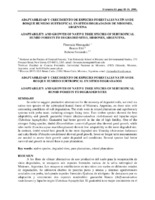Adaptabilidad y crecimiento de especies forestales nativas de bosque húmedo subtropical en sitios degradados de Misiones, Argentina
Adaptability and growth of native tree species of subtropical humid forests to degraded sites, Misiones, Argentina
Date
2016-12-01Author
Montagnini, Florencia
Eibl, Beatriz Irene
Fernández, Roberto Antonio
Metadata
Show full item recordAbstract
A los fines de ofrecer alternativas de uso productivo del suelo para la recuperación de sitios degradados, se ensayaron seis especies forestales nativas de la selva subtropical de Misiones, Argentina. Los ensayos se establecieron en tres sitios con suelos en diferentes estados de degradación. Se utilizaron diseños de parcelas puras y mixtas y sistemas agroforestales asociados con yerba, incluyendo especies forestales fijadoras de nitrógeno. Se destacaron por su adaptación y crecimiento dos especies maderables: guatambú blanco (Balfourodendron riedelianum) y lapacho negro (Tabebuia heptaphylla). El guatambú tuvo mejor crecimiento en el sitio de mayor fertilidad. En el sitio más degradado se destacó una de las especies fijadoras de nitrógeno, el timbó (Enterolobium contortisiliquum), que presentó mejor crecimiento, mientras que rabo molle (Lonchocarpus muehlbergianum) presentó baja adaptación al sitio. El urunday (Astronium balansae) y la caña fístola (Peltophorum dubium) tuvieron buenos crecimientos pero necesitan ser evaluados a más largo plazo. Las plantaciones mixtas presentaron mayores sobrevivencias y crecimientos para varias de las especies ensayadas. In order to suggest productive alternatives for the recovery of degraded soils, we tried six native tree species of the subtropical humid forest of Misiones, Argentina, on three sites with contrasting conditions of soil degradation. The trials were in mixed plantations and agroforestry systems with yerba mate, including nitrogen fixing trees. Two timber species showed the best adaptability and growth: guatambú blanco (Balfourodendron riedelianum) and lapacho negro (Tabebuia heptaphylla). Guatambú had better growth in the site of high fertility. One of the nitrogen fixing species, timbó (Enterolobium contortisiliquum) also showed good growth, while rabo molle (Lonchocarpus muehlbergianum) showed low adaptability to the most degraded site. In contrast, timbó sowed best growth in the most degraded site. Urunday (Astronium balansae) and caña fístola (Peltophorum dubium) showed good growth, however longer term measurements are needed to assess their growth under degraded soil conditions. Several species had better survival and growth in mixed than in pure plantations.
Collections
The following license files are associated with this item:




